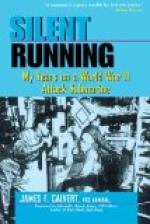In the official war journal where a battalion keeps its records—that precious historical document which will be safeguarded in fireproof vaults one of these days—you may read in cold, official language what happened in one section of the British line on the 8th of May. Thus:
“7 a.m. Fire trench on right blown in at several points ... 9 a.m. Lieutenants Martin and Triggs were hit and came out of left communicating trench with number of wounded . . . Captain Still and Lieutenant de Bay hit also . . . 9.30 a.m. All machine-guns were buried (by high explosive shells) but two were dug out and mounted again. A shell killed every man in one section . . . 10.30 a.m. Lieutenant Edwards was killed . . . Lieutenant Crawford, who was most gallant, was severely wounded . . . Captain Adamson, who had been handing out ammunition, was hit in the shoulder, but continued to work with only one arm useful . . . Sergeant-Major Frazer, who was also handing out ammunition to support trenches, was killed instantly by a bullet in the head.”
At 10.30 only four officers remained fit for action. All were lieutenants. The ranking one of these was Niven, in command after Gault was wounded at 7 a.m. We have all met the Niven type anywhere from the Gulf of Mexico to the Arctic Circle, the high-strung, wiry type who moves about too fast to carry any loose flesh and accumulates none because he does move about so fast. A little man Niven, rancher and horseman, with a good education and a knowledge of men. He rather fits the old saying about licking his weight in wild cats—wild cats being nearer his size than lions or tigers.
Eight months before he had not known any more about war than thousands of other Canadians of his type, except that soldiers carried rifles over their shoulders and kept step. But he had “Fanny” Farquhar, of the British army, for his teacher; and he studied the book of war in the midst of shells and bullets, which means that the lessons stick in the same way as the lesson the small boy receives when he touches the red-hot end of a poker to ascertain how it feels.




